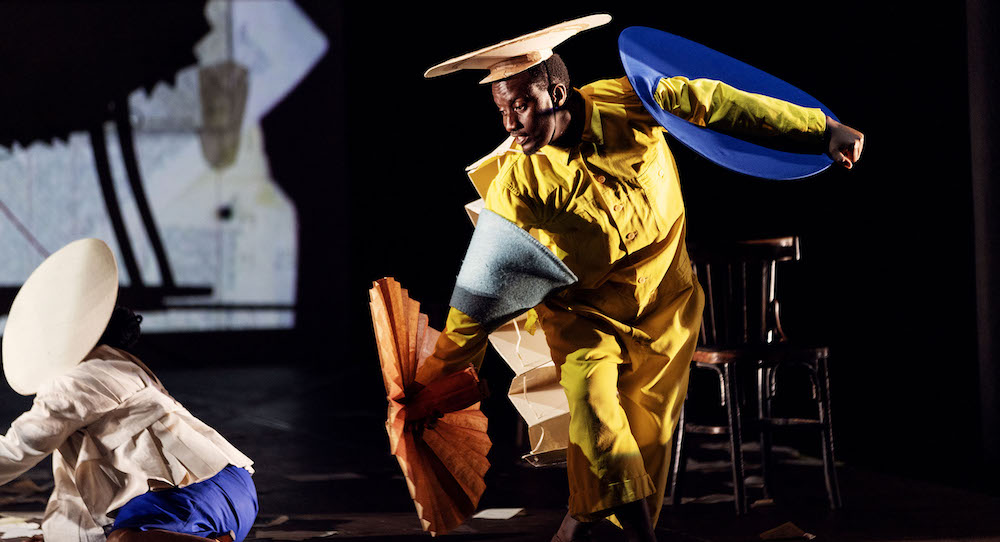Joan Sutherland Theatre, Sydney Opera House, Sydney.
2 November 2023.
William Kentridge’s original work Sibyl is currently playing at the Sydney Opera House (SOH) for a short season, as part of SOH’s 50th anniversary celebrations. Sibyl is a multi-disciplinary theatrical work that encompasses Kentridge’s drawings and artwork, along with movement, voice, original music composition (by Nhlanhla Mahlangu and Kyle Shepherd), shadow play and film. A very cohesive Gesamkunstwek, where every medium used is as essential as the next to form the whole.
Kentridge’s work is based in ideas that form from science, politics, literature, history, and his approach is one that gives space for thought, exploring contradiction and uncertainty. Sibyl put the subconscious to work, all whilst a visual and auditory feast completely absorbed the conscious senses. Only at the end did the culmination of sight, sound and movement bring those two to face each other.
There were sayings composed on paper, projected on film and in shadow, that had a realist edge to them, some harsh, some with a slight sense of hope, all carefully constructed and thematically relevant, albeit not entirely linking together to form any kind of flowing dialogue, per se. The libretto was sung in four variations of Banto language and spoken in English, giving the script varied mediums in the work, and translated as complete musical compositions, not just repetitions of the sayings…it was brilliant, emotive, provocative. The sayings informed the artistry of all the mediums. Each scene had a new musical composition and visual structure, albeit the thematic thread carried through from start to finish in the costume, colours, circular shapes and mechanical movement of the set, all reflecting the same era.
The first half was the shortest, opposing the typical modern day theatrical work in which the first half is usually the longest. The scrim sat at the front of the stage with projections of what looked like circa 19th century manifests, at different angles, and over the top of these was projected a film of Kentridge at work, drawing, and directing his own work. Stop motion was used to have his drawings come to life and explore the movement we intrinsically imagine is there. The cast in this section consisted of the pianist, and four African male vocalists, with the incredibly deep and stunningly beautiful tonal quality that they naturally inherit. The vocals throughout the whole show were just incredible, with harmonies and deep notes that reach that wonderfully low range only some male singers can get to, along with Khosian language clicking sounds that played a percussive role.
The second half utilised the whole stage, with the scrim moved to the back of the stage, utilised for projections and shadow work. There were simple set pieces, including a performer, a typewriter used as a percussive instrument, a wall, and at one point, chairs that moved along the stage, collapsing of their own accord. A struggle of the wills between one of the performers and one of the chairs ensued, where the chair would collapse, the performer would fix it, and when he turned his back, it would collapse again. After some time, he sat on another chair, which collapsed out from under him. Perhaps a comment on the things we build and the temporal nature of them, they will eventually collapse out from under us, the theme of Kentridge’s work seems to have any underlying tone of irony.
The movement in the set pieces, film and the performers, whilst for the most part was not typical dance per se, was choreographed art, incredibly detailed and intentional. No one medium in the work particularly featured, and the movement within served the whole to bring equilibrium, highlighting the brilliance of Kentridge’s ability to create such a complete artistic experience. The way movement was utilised in Sibyl was truly brilliant. It seeped into every aspect of the work, and for those who get the chance to see it, will be something to digest for days after the experience.
Muted colours that made the work look like it could be an oil painting and creative take on another era, used linen and paper, amongst other natural materials, in costumes that included round circular hats and skirts, giving the pieces a movement quality, an aesthetic that was reflected in the circular movement of bodies and a turntable set piece, and the paper arrangement on the scrim.
There was one feature mover, who had her own platform. Her movement was more performance art than dance choreography, creating an incredible shadow projection that morphed and moved over the sketches on the projection, which layered on her face, giving the impression that she was seeing through the work, affected by the constantly rolling piano and sung sayings. Her movement spoke so loudly, and whilst she did not move from her platform, she was key in building the work to its climactic ending, with a long dress that she utilised, swishing, tearing, lifting, throwing it in her impassioned soliloquy of movement. She was in tears at the very end and could not lift her head for the start of the bows and applause, so committed was she to her performance.
Kentridge has created in Sibyl, a unique and whole viewing, hearing and felt experience. Sibyl was an incredibly moving work, each distinctive part of the whole coming together to create a montage that could literally be captured as a picture every moment, so intentional was each detail. He has very mature, informed approach that communicates incredibly effectively. Every artist and keen arts lover should take the opportunity to see, hear and experience Sibyl.
By Linda Badger of Dance Informa.















